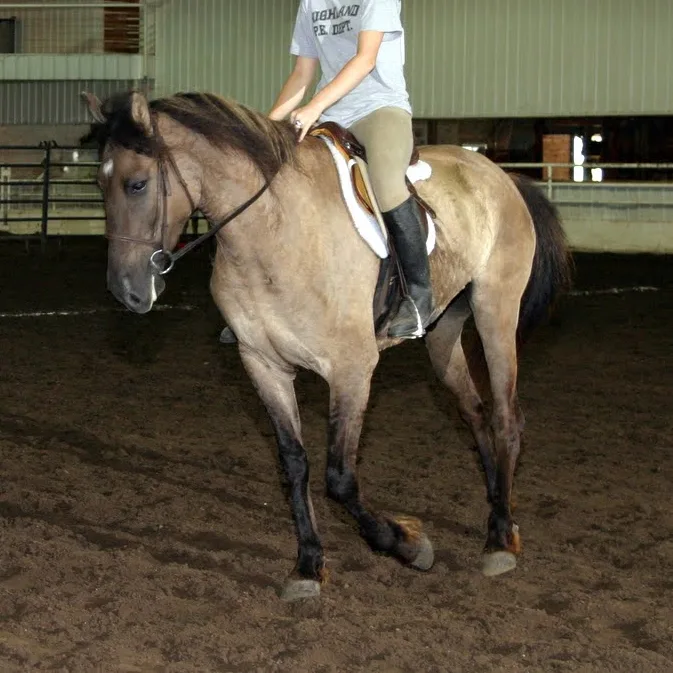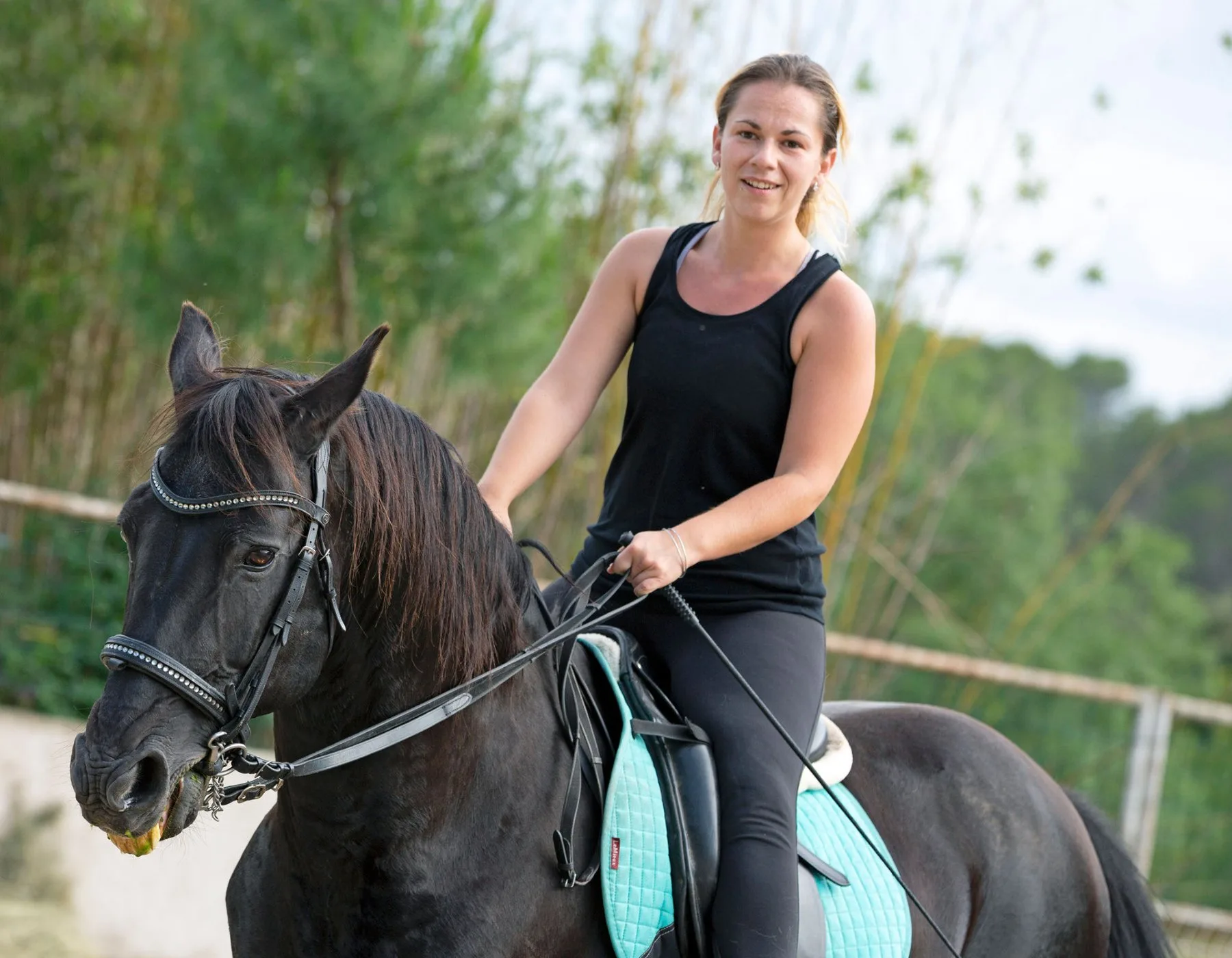A black buckskin horse has smokey or charcoal black fur all over its body with a black mane, tail, and legs.
While a standard buckskin horse is a horse that has yellowish body fur and black mane, tail, and legs, black buckskins are unique. Some people might even mistake a black buckskin for a true black horse or a smoky black horse, but genetically they’re very different.

Shades of Buckskin
Buckskin is an ancient horse color. Until this horse color was named “Buckskin” in the America west in the 19th century, it was called “creamy with black points,” especially in Australia. Regular buckskin occurs when a when a horse with the Creme gene mates with a brown or bay horse.
There are a few different shades of buckskin, ranging from light to dark:
- ⬜⬛ Cream buckskin is off-white with a golden tint and black points.
- 🟨⬛ Standard buckskin is yellowish with a black mane, tail, and legs (and maybe some white markings).
- 🏆⬛ Golden buckskin is a deep gold color that’s really attractive,
- 🟫⬛ Sooty buckskin is darker and browner with some black mixed in.
- ⬛⬛ Black buckskin is the darkest of them all.
Black Buckskin is sometimes called smoky buckskin or yellow-eyed black. It is very difficult to spot just by looking. Most black buckskin are identified by a DNA test. In fact, one buckskin registries doesn’t even recognize black buckskin as an expression of buckskin genetics.
Black Buckskins are Only Possible in a Few Breeds
Certain breeds of horses are extremely unlikely to have the creme gene, required to produce a black buckskin. These breeds include draft breeds (Clydesdales, Percherons, Shires, etc) Thoroughbreds (racing and nonracing types), European warmbloods, Arabian Horses, and many pony breeds.
Breeds in which black buckskins can be bred and registered include Quarter Horse, Shetland, Welsh Pony, Australian Pony, Australian Stock Horse, Connemara, and the miniature breeds.1


Identifying Black Buckskin on a Horse
Three ways to recognize a black buckskin are:
- 🍼 Color at birth: Black buckskins are born pale, and their coat color darkens at the first change of coat. In contrast, black horses are born with blue-black, charcoal, brown, or dark bay fur.
- 🔗 Check the Buckskin Markers: To be a Black Buckskin, a horse first has to meet all the criteria to be a buckskin. Here are three things that are true for every buckskin:
- ✅ All black mane
- ✅ All black tail,
- ✅ black legs (white marking vary).
- 🔎 Examining coat color: Black buckskins have an off-black or smoky shade of black, and they may be mistaken for liver chestnut due to fading. To examine closely, part the thick winter fur. If there’s a dark smoky undercoat, the odds go up that the horse is a black buckskin.
- 🧬 Breeding background: To figure out if a horse is a black buckskin, you need to know about its parents and their breeding history. Black buckskins must have a certain genetic code, which some horse breeds don’t have. If the horse belongs to a breed where the creme gene is common, it’s more likely that the horse is a true black buckskin color.
Black Buckskin Foals
It’s a little easier to recognize the black buckskin horse colo in foals. If a black-appearing baby horse was born pale with a smoky or butter-colored coat that darkened over time, that’s a strong sign the “black” horse is actually a black buckskin! “The true black buckskin is born pale; as a foal it is mouse, fawn, pumpkin or butter-colored and darkens at first shed of coat.”1
For breeding adult horses, if it produces a palomino or buckskin foal when bred to a genetically straightforward mate, the horse is probably a black buckskin.
Gentetics of Black Buckskins
The Genetics of horses can be really complicated. In this section, I’ll try to describe from my experience as a horse breeder about how black buckskin shows up. In this section, I’ve attempted to reduce the complexity down to a Wikipedia: Easy or Reddit-style “explain like I’m 5” format, but be aware that important details may not be included. To learn more about horse color genetics, keep studying. They are fascinating and complex!

The “Incomplete Dominance” Genetics
It’s a phrase with a lot of syllables, but it’s easy to understand: Incomplete dominance is a genetic concept that means when two different genes mix together, they don’t always blend equally.
Sometimes one gene is more dominant than the other, and this can result in a new fur color that’s different from either of the single genes a horse got from its parents.
For example, when a horse with a brown coat (called sorrel) and a horse with a creamy white coat (called cremello) have a baby, the baby can have a new coat color that’s not exactly like either parent. In this case, the baby horse might have a light golden color that’s kind of in between the two colors of the parents. This new color is called palomino. Black Buckskin genetics works in the same way.
There are different shades of buckskin, depending on how much of each gene is dominant. Some shades are lighter and some are darker.
Breeding a Black Buckskin to a Black Buckskin
If two buckskin horses have a baby together, there’s a chance that the baby could have a nearly-white cremello or perlino horse.
This happens when both buckskin parents (even if they are almost coal-black buckskins!) both pass the recessive gene that creates the light color. Breeding two buckskin horses together likely won’t produce a buckskin and generally has been avoided because these very light-colored horses are more prone to certain health issues.
Recessive Genes
When black buckskin horses have a baby, they pass on some of their traits to the baby through their genes. Some genes are dominant, which means they’re really strong and will make the baby look a certain way, even if they only get one copy of the gene.
But other genes are recessive, which means they’re not as strong and will only make the baby look a certain way if they get two copies of the gene – one from each parent.
Breeding risk of pseudo-albino
A black buckskin can produce a pseudo-albino horse if bred to another horse with a creme gene. A pseudo-albino horse is a horse that looks almost white, but not quite- called cremello and perlino by horse breeders.
They usually have blue eyes and pink skin, which can be prone to horse sunburns. Historically, breeders avoided the possibility of producing these colors because of a belief the horses had skin and eye problems. In recent years, however, the cremello and perlino offspring of black buckskin sires have become sought after for their unique color.
Summing Up
In conclusion, a black buckskin horse is a rare variation of the buckskin color, which has smokey or charcoal black fur all over its body with a black mane, tail, and legs. Black buckskins are very difficult to spot just by looking, and most are identified by a DNA test. Certain horse breeds are more likely to produce black buckskins than others, and identifying them involves checking the horse’s markers, examining its coat color, and knowing its breeding background.
- Horse Color Explained: A Breeder’s Perspective. J. Gower. 2021. [↩] [↩]

